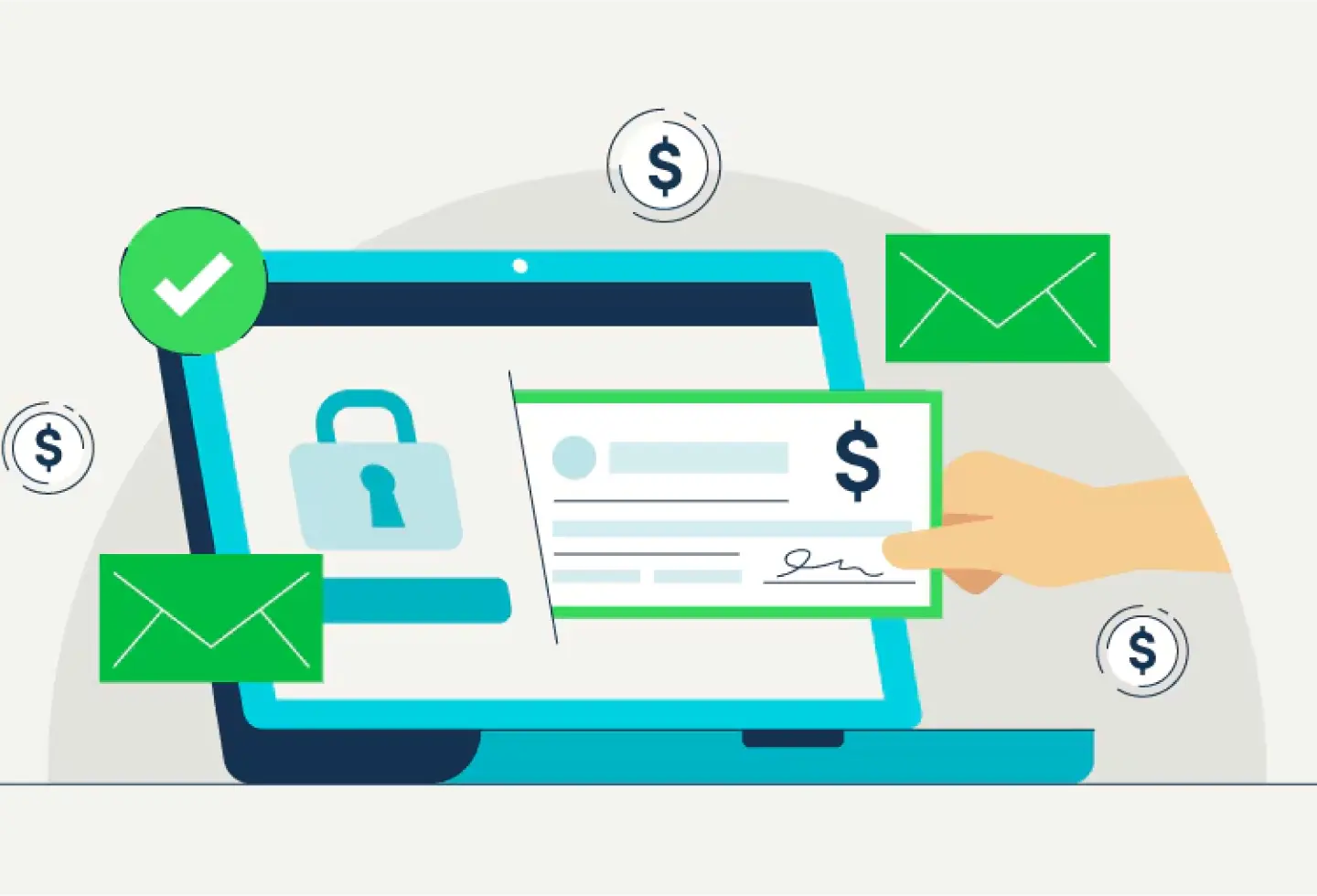These days, businesses are always looking for better ways to accept payments. There’s always something more efficient or cost-effective to strive for.
One payment method that has been gaining a lot of traction is eCheck payment processing.
You must wonder what eCheck is. It’s a nifty way for businesses to accept payments directly from a customer’s bank account. Why deal with cash or physical checks when everything can be done electronically and securely? That too online!
There are quite a few benefits to using eCheck payments for your business. To begin with, it can save you a ton of money in processing fees compared to credit card payments.
It’s also incredibly convenient for your customers. They can pay you directly from their bank accounts without having to mail a physical check or carry cash.
Moreover, eCheck payments are very secure, thanks to strict banking regulations and encryption protocols. You can rest easy knowing that your customers’ sensitive financial information is safe and sound.
Despite all these advantages, eCheck payments haven’t quite hit the mainstream yet. Nevertheless, the numbers speak for themselves .
In 2021 alone, consumers made 29 billion ACH (eCheck) payments totaling $72.6 trillion!
So if you’re a small business owner or an eCommerce seller looking for a better way to accept payments, it might be time to give eCheck processing a chance.
Understanding eCheck Payment Processing
An eCheck, or electronic check, is a digital version of a traditional paper check that allows for the electronic transfer of funds directly from a customer’s bank account to a business’s account.
This process is facilitated through the Automated Clearing House (ACH) network, a robust electronic payment system overseen by the National Automated Clearing House Association (NACHA) and the Federal Reserve.
Here’s how eCheck payment processing works in a nutshell:
First, the customer authorizes the business to withdraw funds from their checking account, typically by providing their bank account and routing numbers.
This authorization can be obtained through an online form, a signed contract, or a recorded phone call. Once authorized, the business submits the payment details to a payment processor, which then initiates the transfer of funds through the ACH network.
The customer’s bank verifies the transaction, and the funds are then withdrawn from their account and deposited into the business’s account within three to five business days.
Key players in the eCheck payment process include the ACH network itself, payment processors (such as Authorize.Net or PayPal), and the respective banks of the customer and the business.
Benefits of Adopting eCheck Payment Processing
eCheck payment processing can yield numerous benefits for businesses of all sizes and across various industries. One of the most significant advantages is cost savings compared to traditional credit card processing.
While credit card transactions typically incur fees ranging from 1.5% to 3.5% of the total transaction amount, eCheck processing fees are substantially lower, often ranging from a flat fee of $0.10 to $1.50 per transaction.
Additionally, eCheck payments offer enhanced security and fraud prevention measures.
Since the funds are directly transferred from the customer’s bank account, there is no risk of chargebacks or disputed transactions, which can be a common concern with credit card payments.
Furthermore, the ACH network employs robust encryption and authentication protocols, ensuring the utmost protection of sensitive financial data.
For businesses that rely on recurring payments, such as subscription-based services or recurring billing, eCheck payment processing can streamline the entire process.
Customers can authorize recurring payments, eliminating the need for manual interventions and reducing the likelihood of missed or late payments.
Moreover, by offering eCheck payment options, businesses can cater to a broader customer base and provide more payment choices, which can enhance customer satisfaction and loyalty.
Overcoming Challenges and Addressing Concerns
While eCheck payment processing offers numerous advantages, it’s essential to acknowledge and address potential challenges and concerns.
One common concern is the processing time and clearance delays associated with eCheck payments.
Unlike credit card transactions, which are typically processed within seconds, eCheck payments can take three to five business days to clear and be deposited into the business’s account.
To mitigate the risk of bounced payments, businesses should implement robust verification processes and consider partnering with reputable payment processors that offer advanced fraud detection and risk management solutions.
Additionally, businesses must ensure compliance with applicable regulations and guidelines set forth by NACHA and the Federal Reserve to avoid potential legal or financial penalties.
Customer education and adoption can also pose a challenge, as some consumers may be unfamiliar with eCheck payments or hesitant to provide sensitive banking information.
Clear communication, transparency, and reassurance regarding the security and convenience of eCheck payments can go a long way in overcoming these hurdles.
Best Practices for Successful eCheck Payment Processing
To maximize the benefits of eCheck payment processing and ensure a smooth implementation, businesses should follow industry best practices.
First and foremost, it’s crucial to choose a reputable and reliable payment processor that specializes in eCheck processing and offers robust security features, fraud protection, and excellent customer support.
Integrating eCheck payment options seamlessly into existing systems, such as e-commerce platforms, accounting software, and customer relationship management (CRM) tools, can streamline operations and enhance the overall customer experience.
User-friendly payment forms, clear instructions, and intuitive interfaces can further improve the adoption and utilization of eCheck payments.
Continuously monitoring and reporting on eCheck payment processing performance is essential for identifying areas for improvement, optimizing processes, and making data-driven decisions.
Regular analyses of transaction volumes, success rates, and customer feedback can provide valuable insights and inform future strategies.
Real-World Examples and Case Studies
The benefits and efficacy of eCheck payment processing are not mere theoretical concepts; they have been proven time and again by businesses across various sectors.
For instance, a property management company that adopted eCheck payments for rent collection saw a significant reduction in processing costs, improved cash flow, and a decrease in late or missed payments.
An e-commerce retailer that introduced eCheck payment options alongside credit card payments reported a substantial increase in customer satisfaction and loyalty, as well as a noticeable reduction in chargeback rates and disputed transactions.
Industry experts and payment processing veterans often emphasize the importance of embracing eCheck payments as a strategic move for businesses seeking to streamline operations, reduce costs, and enhance customer experiences.
Their insights and lessons learned can serve as valuable guidance for businesses navigating the world of eCheck payment processing.
As eCheck payment processing continues to gain traction, it’s essential to stay informed about the latest trends and advancements in this space.
One emerging trend is the rise of Same-Day ACH, which allows businesses to receive eCheck payments on the same day they are initiated, significantly reducing processing times.
This can be particularly beneficial for businesses with time-sensitive transactions or those seeking to improve cash flow and liquidity.
The integration of eCheck payments with mobile payment solutions is opening up new avenues for businesses to offer their customers a seamless and convenient payment experience.
By leveraging mobile apps and digital wallets, customers can initiate eCheck payments on-the-go, further enhancing the accessibility and convenience of this payment method.
As cybersecurity threats continue to evolve, payment processors and financial institutions are constantly enhancing their security measures to safeguard sensitive financial data.
This includes implementing advanced encryption techniques, multi-factor authentication, and real-time fraud monitoring systems, ensuring that eCheck payment processing remains a secure and trusted payment method for businesses and consumers alike.
Conclusion
Making eChecks part of your payment plan is a smart business move. It can really streamline things, lower costs and make customers happier too.
If you take the time to learn how eChecks works, your business has a chance of reaping huge benefits.
As online shopping evolves, companies that adopt new payment methods like eChecks will have a better chance of moving forward.
Being able to offer secure, affordable, and convenient ways to pay can be what pushes you ahead in the market now.
Whether you’ve been an entrepreneur for years or are new to running an eCommerce store, look into how eCheck payment processing could elevate your business.
Embrace this innovative solution! Your operations can get easier, expenses can decrease, and customer satisfaction will improve.





